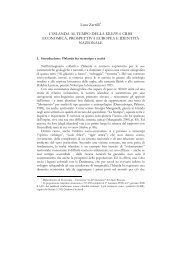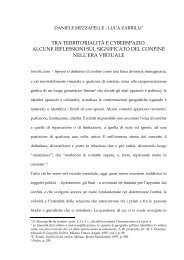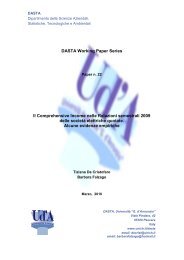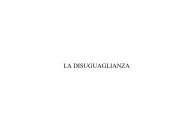DASTA Working Paper Series Life Cycle Assessment in the tourism ...
DASTA Working Paper Series Life Cycle Assessment in the tourism ...
DASTA Working Paper Series Life Cycle Assessment in the tourism ...
Create successful ePaper yourself
Turn your PDF publications into a flip-book with our unique Google optimized e-Paper software.
<strong>DASTA</strong> – <strong>Work<strong>in</strong>g</strong> <strong>Paper</strong><br />
Data quality Data were ga<strong>the</strong>red through direct <strong>in</strong>terviews, literature<br />
analysis or calculated us<strong>in</strong>g comput<strong>in</strong>g systems (for <strong>the</strong> def<strong>in</strong><strong>in</strong>g of <strong>the</strong><br />
distances covered by <strong>the</strong> aeroplanes).<br />
Environmental impact assessment method Indicators were chosen to<br />
supply a simplified representation of <strong>the</strong> environmental impacts: energy use,<br />
food consumption, solid waste production, water use, release of chemicals<br />
and waste cook<strong>in</strong>g oil. The ecological footpr<strong>in</strong>t analysis jo<strong>in</strong>ed <strong>the</strong> above listed<br />
<strong>in</strong>dicators for <strong>the</strong> comparative evaluation.<br />
Special features The responsible <strong>tourism</strong> case study highlights <strong>the</strong><br />
significant role of tour operators <strong>in</strong> educat<strong>in</strong>g customers to respect <strong>the</strong><br />
environment. Unlike o<strong>the</strong>r studies, <strong>the</strong> author used a def<strong>in</strong>ition of <strong>tourism</strong> to<br />
outl<strong>in</strong>e <strong>the</strong> boundaries of <strong>the</strong> systems to be compared.<br />
Ma<strong>in</strong> limitations Although <strong>the</strong> importance of evaluat<strong>in</strong>g <strong>the</strong> local impacts<br />
were highlighted, <strong>the</strong>y were only <strong>in</strong>cluded partially among <strong>the</strong> evaluation<br />
<strong>in</strong>dicators. Despite <strong>the</strong> fact that a considerable effort was made to collect data,<br />
those regard<strong>in</strong>g certa<strong>in</strong> processes are lack<strong>in</strong>g. For example, as far as <strong>the</strong><br />
phase of tourist activities of <strong>the</strong> holiday <strong>in</strong> Slanchev Bryag is concerned, <strong>the</strong><br />
data collection is limited to <strong>the</strong> energy used dur<strong>in</strong>g tourist transfers, while <strong>the</strong><br />
environmental burdens of o<strong>the</strong>r tourist activities (e.g., restaurants, nightclubs,<br />
shops and so on) are neglected. The allocation issue is not dealt with even if<br />
<strong>the</strong> necessity with<strong>in</strong> different processes can be recognized.<br />
3.5 IO-LCA of <strong>the</strong> New Zealand <strong>tourism</strong> sector (Patterson, McDonald,<br />
2004)<br />
Methodology IO-LCA.<br />
Product The <strong>tourism</strong> <strong>in</strong>dustry was not described by <strong>the</strong> authors.<br />
Objectives One of <strong>the</strong> prime objectives was to assess <strong>the</strong> direct, <strong>in</strong>direct<br />
and future environmental effects of <strong>the</strong> New Zealand <strong>tourism</strong> sector. The<br />
study was also carried out so as to develop <strong>the</strong> knowledge of susta<strong>in</strong>able<br />
<strong>tourism</strong> identify<strong>in</strong>g <strong>the</strong> l<strong>in</strong>ks between <strong>the</strong> environment and <strong>the</strong> economy.<br />
System boundaries All <strong>the</strong> <strong>in</strong>puts supplied by o<strong>the</strong>r sectors to <strong>the</strong> <strong>tourism</strong><br />
sector were identified and quantified. The system boundaries are from <strong>the</strong><br />
moment <strong>in</strong> which <strong>the</strong> tourists leave <strong>the</strong>ir home until <strong>the</strong>ir return. The study<br />
does not <strong>in</strong>clude <strong>the</strong> impacts l<strong>in</strong>ked to <strong>the</strong> goods imported from overseas due<br />
to lack of data available. The <strong>in</strong>ability to control <strong>the</strong> environmental impacts<br />
l<strong>in</strong>ked to <strong>the</strong>se goods was revealed as justification for this exclusion.<br />
Data quality The data used are from official statistical sources (Statistics<br />
New Zealand, 1999) and <strong>the</strong> period of reference of <strong>the</strong> study is 1997/1998.<br />
Environmental impact assessment method In <strong>the</strong> application of <strong>the</strong> IO-LCA,<br />
<strong>the</strong> follow<strong>in</strong>g <strong>in</strong>dicators of environmental pressure were used: energy (TJ),<br />
water use (m 3 ), BOD5 (kg), nitrate discharges (kg), phosphorus discharges<br />
(kg), water discharges (m 3 ) land use (ha) and CO2 (t).<br />
De Camillis, Raggi, Petti 8






